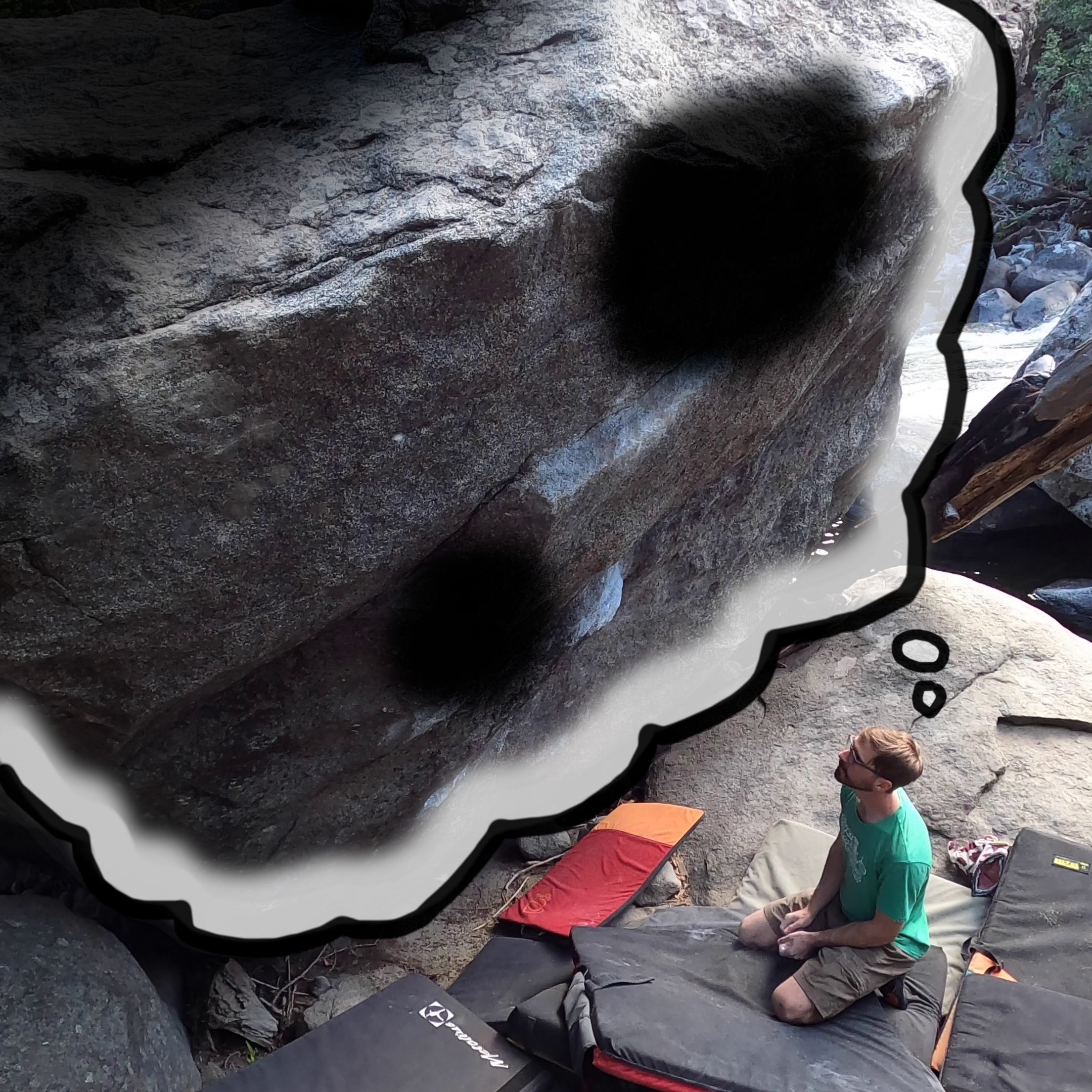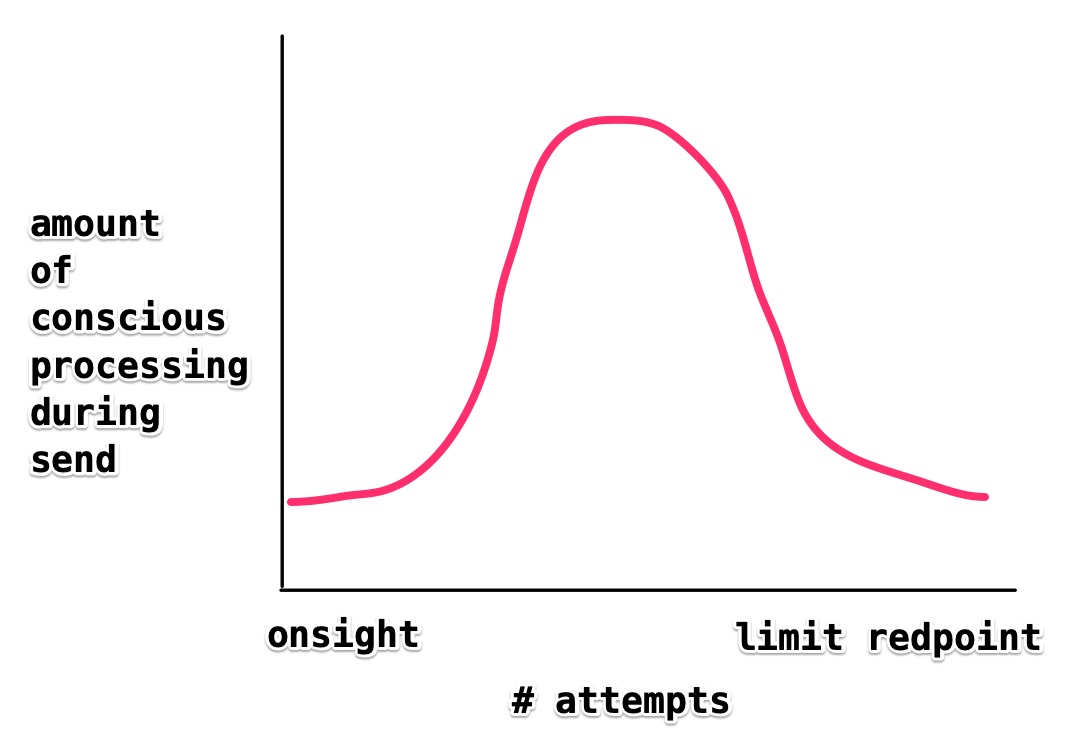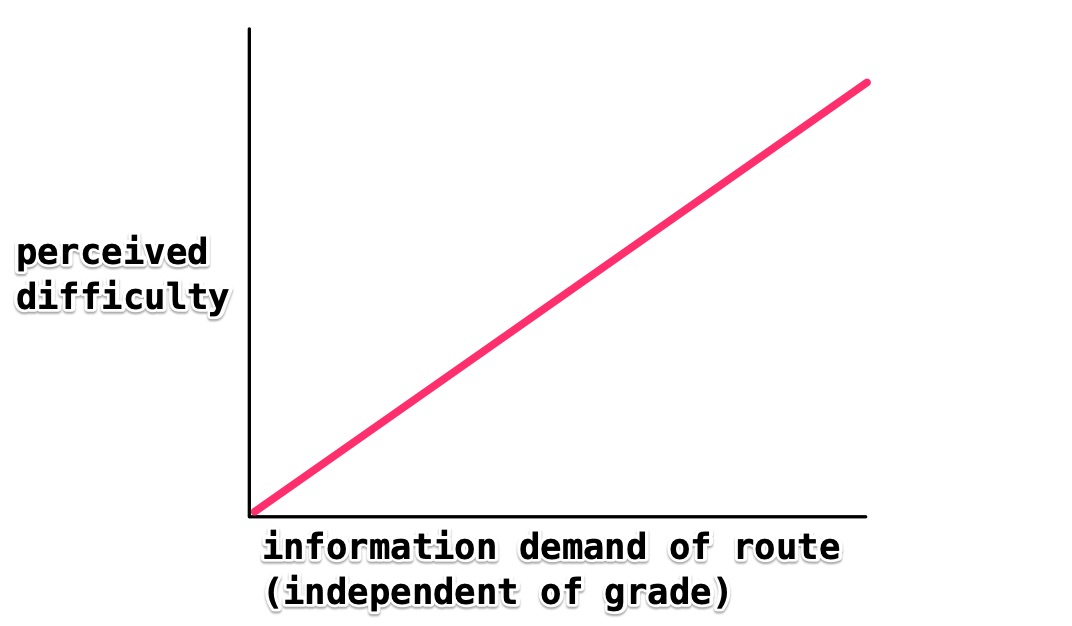
I like to joke that I’ve never actually redpointed a hard route at Smith Rock. It’s notoriously technical, engaging, and diabolical; but compared to bouldering and some other sport crags, generally not that physical. (Don’t @ me, Oregon.) So much mental effort goes into a successful redpoint on Smith terrain that the eventual send is often just a lucky intersection of confidence, courage, conditions and not forgetting the dance moves. If those things line up, you tend to find yourself at the chains, wondering what all the fuss was about. In this sense, the routes are only hard until you do them. The send is a tiny punctuation mark at the end of a long, rambling sentence.
On the other hand, by far the most taxing and hardest experiences I’ve had were the routes that weren’t that hard, but I sent quickly: fighting the entire way, making mistakes but recovering, devastatingly pumped, terrified of falls I hadn’t road-tested, and perhaps most notably, 100% paying attention to all the suffering and fear bouncing around my head.
The goal of the climber is to achieve an ideal state of performance where few conscious decisions need to be made.
While redpoint climbing and onsight climbing are fundamentally different, in a funny way the goal of the climber is the same: to achieve an ideal state of performance where few conscious decisions need to be made. To be more specific, we’re looking to minimize the amount of conscious mental effort to a level which can be performed under extreme stress, or in between sections of hard climbing. This state is casually referred to as the flow state.
Often, “in-between” sends – the 2nd try, or 2nd-day-first-try type sends – encapsulate sending when mostly or partly out of the flow state. These efforts are much more conscious, combining the feedback from the first attempt with conscious processing both on the ground and on the wall. In this way, a limit redpoint after many attempts and a hard onsight are perhaps more similar modes of climbing than many other ascents that fall in between them in effort level. This can be visualized as a bell curve:

There’s no real data here, of course. Reality is complicated. Onsights are often a conscious mess, especially if they involve cruxes and rests more than flowy climbing. Sometimes the redpoint go isn’t as perfect as we’d like. And occasionally everything does line up and find ourselves in a flow state we feel like we didn’t earn, half-onsighting our way up a route. But generally I think this curve fits a scatter plot of all various experiences.
Redpoint skills & mental maps
Climbers use various skills to break down goal routes and problems. These skills are numerous, including constructing sequences, selecting and achieving links, highpointing and lowpointing, re-evaluating sequences after redpoint attempts, and many others. The purpose of these redpoint skills is to work our way from an initial, purely conscious performance state to an intuitive, almost entirely physical performance state. Redpoint practice is basically working towards the ability to climb the route without thinking, as illustrated by the bell curve.
Frequently climbers will report that their send of a route that took months of effort as feeling completely easy. Our perception of difficulty is probably directly tied to our evolutionary preference to keep our brain in an intuitive mode. Running a brain is metabolically expensive, and we aren’t inclined to do it unless we have to.
Anyone who’s read the book Thinking Fast and Slow will recognize the paradigm here; the book makes a distinction between Type I thinking (intuitive, fast, loves carbs) and Type II thinking (conscious, effortful, annoying pedantic nerd in all of us.) An ideal onsight or limit redpoint would be almost entirely Type I thinking, turning the ol’ thinky motor on only to make absolutely essential decisions. The use of redpoint skills is mostly using that expensive Type II processing power to make decisions now so you don’t have to make them later during your redpoint attempt. Frontloading mental effort to the rehearsal, to save precious processing power for the physical execution.
Climbing difficulty vs mental bandwidth
Where it gets interesting is the intersection of this psychological phenomenon and an increasing difficulty of movement. The concept scales to the climber. For example, few climbers look more fluid and intuitive on the wall than Ondra. Of course, even Ondra can’t onsight 5.15c or d. But when he redpoints one, his movements look eerily similar to when he’s onsighting something easier. (Just that for him, “something easier” is still 5.14.)
The same is essentially true for all of us. The general population might be more stressed while climbing a ladder than the average 5.8 climber. A 5.12 climber can generally intuit their way through a 5.10 while carrying on a conversation. Obviously your average 5.10 isn’t literally like a ladder; the difference at play can be measured by the amount of conscious engagement required on the part of the climber. This can be thought of as climbing bandwidth. Deeper intuitive knowledge of climbing movement = more bandwidth, as well as higher fidelity and economy on submaximal terrain.
As the climbing gets more difficult, we need to gather more information about a climb in order to achieve an ideal performance state. This information is our mental map, and its complexity is proportional to the challenge. For a limit redpoint, the map needs to be concrete and thorough. For an easier onsight it might just be a glance at the terrain. For a limit flash attempt, it needs to be as solid as we can make it without receiving any physical feedback from the climb.

This information-gathering process is a huge part of the reason limit redpoints take so long, and why we feel so cheated when we send a supposedly ambitious long-term project faster than expected. Similarly it’s why we feel frustrated when the process of redpointing goes on past the point of consistent learning. We correlate the length of the information-gathering process with difficulty. This causes two common patterns of bad thinking in climbers:
- If we sense that we’ve stopped learning on a project, we might feel like we then deserve to send it. This is self-evidently backwards. We should only assume the learning stops when we send – and not necessarily even then. The masterpoint technique of re-redpointing climbs is all about squeezing more learning out of a climb you’ve already sent.
- We forget that some types of climbing inherently require more information, or that we as climbers may have better information banks for certain types of climbing. This is why so many climbers become “allergic” to technical slab and face climbing, or to parkour-style movement: it’s information-dense and so it seems harder than we want it to. We should recognize that information density is a separate factor of difficulty from a route’s grade.
Removing unknowns as a redpoint strategy
Armed with the knowledge that the point of the redpoint process is to reduce conscious effort and decision-making, we can make some adjustments to it.
Every trip up the wall is a learning attempt. All the data is useful; it’s up to you to make good use of it.
First, tactically we can recognize that with limit redpoints, every trip up the wall is a learning attempt. You might hangdog your way up everything multiple times, or prefer to go for it as soon as possible – regardless of your rehearsal style, what you’re doing is building a familiarity with the challenge that will reduce conscious effort later. This is important, because often it’s easier to make progress if we accept that it might only be incremental. Just think: I am building my mental map. Any new information gleaned is part of that map, or something I can rule out as being not part of it. All the data is useful; it’s up to you to make good use of it.
Second, we should take a more deliberate approach to the use of our conscious and intuitive modes. Recognize what questions the route is asking you. Pay attention to the decisions you’re making during each attempt on the project. Try to predict sections of the route that are going to cause conscious effort, and be ready to commit to switching on that Type II engine when you get there. And conversely, work towards being able to flip back into that Type I intuitive mode using breathing or other strategies.
As far as “flipping modes,” I doubt many climbers think about it this way literally; the point is not to become a robot, it’s to play with new ways of thinking to help grow as a climber. We should recognize the importance of mental maps, and practice our skills for building those maps. We should also work on our ability to climb with everything from no map at all (true onsighting) to having the entire route memorized down to each subtle movement, breath and grain of rock.
Third, we should recognize that the process of learning is indefinite. Even if redpoint attempts might be less learning-oriented than initial beta forays, we should always be trying to glean new information from our projects. As soon as you stop learning, you’re setting yourself up for a failure of expectations. And as I quote constantly, perhaps to the annoyance of my friends & clients, “expectations are the death of joy.”
Spectacular climbers can often mingle these strategies so effectively, it’s hard to tell when they’re onsighting and when they’re on ground they’ve tread a hundred times. This is the level of mastery to which we should all aspire, and it begins with recognition that our mental map of a climb is the linchpin to effectively performing on it.
A few post hoc notes:
- This distinction between a self-perceived “easy” and self-perceived “hard” send is part of the reason grades are so damnably frustrating. Our inability to extricate our personal experience on a route from the subjective challenge it offers is clearly problematic to assigning arbitrary difficulty. Perhaps even more problematic than the morphological factors we like to hammer away at culturally. Or, put another way: never trust someone’s opinion of a grade unless you know what they went through to get the send.
- It’s no coincidence that much of this discussion of mental maps is focused on sport climbing, and not bouldering. Bouldering obviously involves many of the same mechanics, and boulderers can benefit enormously from the redpoint skills and conscious/intuitive distinction work that comes from sport climbing. But in truth, with most boulders, there’s just often less mystery to contend with. Boulder attempts aren’t usually limited by social and fatigue factors in the same way as routes. In fact, a strong argument could be made that boulderers are too good at putting together the entire picture of something before climbing it; perhaps that’s why so many avid boulderers are notoriously bad at onsighting routes.
One thought on “Mental Maps for Climbing: The intuitive/conscious processing bell curve”